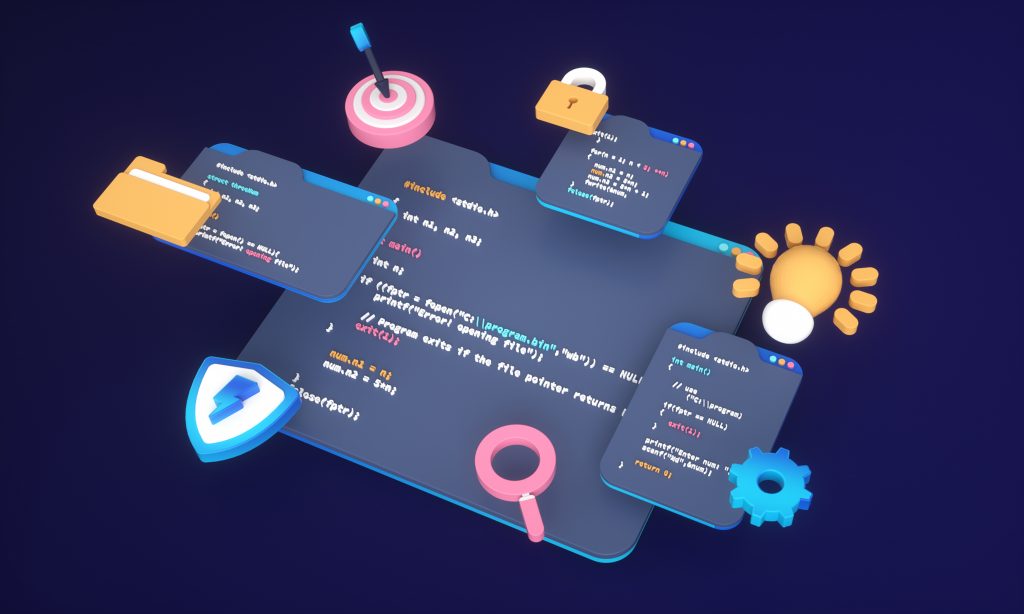
1. Introduction to Backend Development in Mobile Apps
The role of Backend Development in mobile app functionality is crucial as it powers the entire application interaction. Consider it the ‘engine’ that enables a smooth and efficient user experience.
What’s in the Backend?
The backend houses a series of unseen processes enabling your favorite apps to load, update, and interact suitably. Everything needed for the app to function correctly resides here.
Backend Development is the untold magic that keeps a mobile application running smoothly.
Backend Development Components
- Server-Side Programming: This involves writing code that the server executes to support user experiences.
- Database Management: Operations about data storage and retrieval – another core aspect of Backend development.
- Server Management: This includes activities related to server operation management.
- API Development: APIs, which facilitate efficient communication between software components, are integral to backend development.
Leveraging APIs for Mobile App Development
We’ll further delve into the role of APIs, their implementation in mobile app development, benefits, types, and best practices in ensuing sections. Joined with Backend Development, APIs are pivotal in creating a sophisticated mobile application development experience.

2. Implementing APIs in Mobile App Development
2.1. Understanding APIs
APIs, or Application Programming Interfaces, play a crucial role in application development by facilitating effective communication between different software applications. Their importance can be likened to that of bridges, connecting different ‘islands’ of applications.
APIs – The Bridge of Communication
In the absence of an API, two applications, say A and B, may not be able to relay information effectively. The role of an API comes into play here as a ‘translator’, dissecting requests from Application A into a language that B can comprehend, and vice versa.
Extending Capabilities with APIs
APIs not only enable interaction but can also expand the capabilities of applications. With the assistance of the right APIs, developers can integrate their apps with other services, improve user experiences, and enhance their applications’ overall functionality.

Real-World API Implementations
Real-world examples that demonstrate the usage of APIs include services like Twilio, Stripe, and Google Maps. By offering APIs, these businesses can extend their services to other applications, broadening their impact and reach.
2.2. Benefits of Using APIs
If you’re a mobile application developer, APIs can prove to be indispensable tools. But what exactly are the benefits that APIs bring to the table? Let’s discover that through the following key points.
Enhanced Integration and Versatility
APIs allow seamless integration of numerous multi-platform capabilities. Integration options could range from social media giants like Twitter and Facebook to professional networks like LinkedIn. This multi-platform integration makes your app richer and more engaging for users.
Significant Time and Cost Efficiency
APIs are essentially pre-existing pieces of code that developers can tap into. This eliminates the need to code everything from scratch, leading to faster development, deployment, and significant cost savings.
Improved User Experience
APIs can leverage various web services to provide a seamless and engaging user experience. An app that properly utilises APIs can ultimately serve as a one-stop solution for users.
Efficient Data Access
APIs provide efficient and reliable access to vast data resources. Developers can easily integrate APIs from services like Google Maps for location data or payment gateway services like Stripe to facilitate in-app payments.

Potential Monetization Opportunities
There are several incentivised programs for developers offered by API-owning companies. This not only adds more features to the app but also acts as a potential revenue source.
Overall, an effectively implemented API can greatly enrich a mobile app, satisfying users while potentially generating revenue. Especially with the rise of REST APIs, the scope for innovation and success in app development continues to expand.
2.3. Types of APIs
Exploring Different Types of APIs
In your quest to understand APIs in depth, it’s imperative to differentiate two main types:
- Open APIs: Also known as Public APIs, these are openly accessible with no restrictions attached. As a developer, you’re free to interact and establish connectivity with the platform.
- Partner APIs: Unlike open APIs, these are selectively shared with trusted business partners. They come with specific terms and conditions and allow for cross-integration of services between different platforms.
Deciding between open or partner APIs hinges on your project’s needs and objectives. Key considerations may include the target audience, nature of the application, and desired user experience.
2.4. Implementing APIs in Mobile Application Development: A Step-by-Step Guide
Step 1: Grasp the basics of RESTful API
So, how to start implementing APIs in your mobile app? Begin by understanding what RESTful API means and its role in enhancing communication between your mobile app and the backend server. Its primary characteristics such as simplicity, speed, and scalability make it a preferred choice for mobile app development.

Step 2: Dive deeper into the world of REST and RESTful APIs
To effectively use RESTful APIs, you need to know about the important facets of REST (Representational State Transfer). REST facilitates interaction with data or services in APIs via URL endpoints. But to be genuinely RESTful, an API should meet specific criteria, like client-server architecture, stateless communication, and cacheable data.
Step 3: Identify and overcome challenges with RESTful APIs
Of course, implementing RESTful APIs does come with its unique challenges. Maintaining endpoint consistency, reducing long response times, and ensuring top-level security are a few constraints that you might confront.
Step 4: Understand the future significance of RESTful APIs
Don’t adopt RESTful APIs just for the now; understand their future significance as well. With more businesses turning to cloud and microservice architectures, RESTful APIs and their versatility and ease of use are expected to lead the way.

Step 5: Deep dive into CRUD operations with RESTful API
Now, to put your learning into practice, create a CRUD (Create, Read, Update, Delete) application using RESTful APIs. Remember, CRUD actions correspond to HTTP methods POST, GET, PUT, and DELETE.
Step 6: Explore usage scenarios
Look at existing apps to understand RESTful APIs better. For instance, in e-commerce apps, customers can view, add, modify, and delete products to and from the cart using different HTTP methods. These operations make use of CRUD!
Step 7: Analyze real-world examples of RESTful APIs
Twilio, Stripe, and Google Maps are excellent real-world examples of RESTful APIs. They harness RESTful principles to offer cross-platform services seamlessly.
Step 8: Address the challenges
While REST APIs are beneficial, they do pose certain challenges. You’ll need to manage API versions, control data volumes, ensure security, and perform thorough testing.
Step 9: Recap the important points
Finally, review these steps and key aspects. This roundup will prepare you to effectively implement APIs in your mobile application development projects.
3. Best Practices for Backend Development and APIs
3.1. Scalability and Modularization
Designing for Scalability
Backend development for mobile apps needs to consider scalability. As your app gains users, it will see more traffic and data loads. Scaling your backend efficiently can prevent performance issues and keep the app running smoothly. Implementation of tools and frameworks that can auto-scale based on traffic volume is a smart approach. Utilization of load balancers can ensure even distribution of network traffic across several servers.

Embracing a Modular Architecture
Making your backend architecture modular can effectively manage changes and updates. By breaking down app functionalities into separate components, you enhance maintainability, simplify debugging, and allow teams to work independently on different functionalities. Modular designs also open the door for microservices and serverless architectures, reducing reliance on monolithic structures that can be difficult to maintain over time.
3.2. Data Validation and Security Layers
Implementing Thorough Data Validation and Sanitization
In backend development, data validation and sanitization are fundamental. They provide a vital line of defense against malicious inputs and safeguard system integrity. Here’s a closer look:
- Data Validation: This process ensures incoming data fits specific criteria. It validates data types, lengths, mandatory fields, and formats.
- Data Sanitization: Once validated, data must be sanitized before further storage or processing. This step cleanses data of potentially harmful elements, essential when handling user inputs susceptible to hacking attempts.
Together, these steps enhance system security, maintain data integrity, and contribute to a robust, secure backend for your mobile app.
Ensuring Multiple Layers of Security to Safeguard User Data
The importance of security in backend development cannot be overstated. Protecting user data requires a multi-tiered defense system. If one layer fails, multiple other barriers should remain to stop intruders.
- Multi-layered Security: Incorporate multiple layers of defenses, including strong data encryption, two-factor authentication (2FA), robust access controls, secure API endpoints, firewalls, and intrusion detection systems.
- System Updates: Always stay updated with the latest patches and security fixes to counter new vulnerabilities.
- Secure APIs: Part of your security measures should involve creating a secure API, which includes using correct HTTP status codes, ensuring endpoint consistency, creating secure unique identifiers, and handling API versioning.
By ensuring such security measures, you can effectively protect your backend systems and reinforce your application’s overall security posture.

3.3. Error Handling and Graceful Responses
Efficient Error Management with RESTful APIs
One of the hallmarks of a well-implemented RESTful API is its proficiency in handling error messages and status codes, which significantly streamlines the troubleshooting process.
Key Role of HTTP Response Codes
- 200 (OK)
- 201 (CREATED)
- 204 (NO CONTENT)
- 400 (BAD REQUEST)
- 403 (FORBIDDEN)
- 404 (NOT FOUND)
- 500 (INTERNAL SERVER ERROR)
These HTTP response codes provide quick feedback about the outcome of an action, making debugging more manageable.
Importance of Error Handling for User Experience
Proper error handling is crucial for enhancing the end user’s experience. That’s where RESTful APIs truly shine. They efficiently guide users through resolving issues, reducing frustration, and leading to a smoother app experience.
3.4. Testing and Debugging
Testing: The Vital Step
An indispensable part of mobile app development is rigorous testing of APIs and backend processes. Challenges may include schema updates, sequence of API calls, and system integrations; nonetheless, careful testing ensures optimal API functionality and an unparalleled user experience.
Debugging: Your Unexpected Hero
Efficient debugging is paramount to promptly identify and resolve issues. It involves detailed code inspection, API response verification, and assurance of precise HTTP status codes by a well-implemented RESTful API.

The Twin Powers: Testing and Debugging
Stringent testing coupled with rapid debugging not only boosts your app’s performance but also enhances its scalability. This synergy prepares your app for growth and keeps up with the advancements in the tech landscape.
3.5. Monitoring and Optimization
Monitoring Backend Performance
Keeping an eye on backend performance and resource usage is essential. This early-detection approach to potential issues, such as slowing data operations, prevents user experience disruption. Cloud platforms like Google Cloud Monitoring or Amazon CloudWatch offer excellent monitoring solutions.
Optimizing API Endpoints
Refining server-client interaction is the essence of API endpoint optimization. This process, mandating efficiency in data exchange, often leverages RESTful APIs to lend structure to resources hence enhancing intuition in usability.
Techniques of API Optimization
Several techniques apply in the optimization of APIs featuring payload size reduction, usage of caching and proficient endpoint design. This process significantly contributes towards a mobile app’s swiftness, responsiveness and user experience

4. Navigating Challenges in Backend Development
4.1. Keeping Up with New Technologies
In the ever-evolving landscape of technology, closely keeping up with the latest developments stands as a significant challenge for backend developers. Rapid advancements in programming languages, innovative frameworks, and cutting-edge tools leave developers in a constant race to update their skills and knowledge, ensuring their work stays relevant, competitive, and effective.
4.2. Scalability and Performance Optimization
Among the extensive range of backend developer responsibilities, achieving excellent performance and scalability often prove to be particularly complex. These tasks require a profound understanding and handling of code optimization, efficient database queries, and the deft management of server configurations. This ensures the system’s preparedness to comfortably handle increasing quantities of traffic and data, maintaining smooth functioning.
4.3. Ensuring Data Privacy and Security
Data security and privacy are paramount in the digital world. Backend developers are tasked with the challenge of implementing solid security measures, encryption methodologies, and strict access controls to safeguard user data. Furthermore, adhering to stringent privacy regulations like the GDPR amplifies the complexity stakes of backend development tasks, necessitating an additional level of skill and diligence.
4.4. Integration of AI and Machine Learning
The integration of Artificial Intelligence (AI) and Machine Learning (ML) technologies into backend development presents its own unique set of challenges. Backend developers need to gain a thorough understanding of the data pipelines, model integration protocols, and execute these applications efficiently. The task demands a blend of data science skills and backend development expertise, making it a challenging task for traditional developers.

4.5. Cloud Computing and Serverless Architectures
As businesses increasingly migrate their architecture to the cloud or choose serverless architectures, several challenge markers arise. These include issues of scalability, management of costs, deployment complications, and mitigating the risk of vendor lock-in. Adapting to these transformations necessitates developers to learn new skills and keep pace with the evolving technological environment.
4.6. Managing Microservices and Distributed Systems
While microservices architecture affords a reasonable degree of flexibility and scalability, they bring their own set of management complexities. Backend developers will need to coordinate multiple services, consistently ensure system integrity, and handle any arising failures. Additionally, managing distributed systems call for robust error handling mechanisms, efficient data synchronization, and advanced fault tolerance strategies.
5. Wrapping Up
Mastering backend development and APIs is a critical aspect of building functional and thriving mobile applications.
- They act as indispensable tools that facilitate a smooth connection between the frontend user interfaces and backend services, paving the way for smooth data transfers.
- This significant role helps in enhancing user experiences and aids in optimizing business processes.
- Furthermore, APIs magnify the potency of backend development by offering unlimited opportunities for integration, versatility, scalability, and efficiency.
During your journey as a developer, it’s crucially significant to stay abreast of evolving trends and advancements in backend technologies and APIs.
- Adopting industry best practices will not just amplify your skill set, but also provide you a competitive edge in this rapidly advancing field.
- Therefore, continuous exploration and learning should never be compromised.
- Your persistent endeavor in comprehending backend development and APIs will indeed become one of your most formidable tools in crafting dynamic, innovative, and cutting-edge mobile applications.
6. Frequently Asked Questions
Backend development in mobile apps involves managing and organizing data and ensuring communication between the mobile application and the backend server. It encompasses aspects such as server management, data storage, and system operations.
APIs act as intermediaries facilitating communication between different software systems. In mobile app development, they enable apps to interact with other apps and services by sending and receiving data. APIs tee up the potential for expanding the functionality of mobile apps without extensive coding.
APIs present several benefits like enhancing integration and versatility, providing time and cost efficiency, improving user experience, ensuring efficient data access, and even creating potential monetization opportunities.
There are several types of APIs, including RESTful APIs, SOAP APIs, JSON-RPC, and XML-RPC. Each of these have different usage scenarios and are defined by unique design principles and structures.
Best practices for backend development and APIs include designing for scalability, implementing proper data validation, ensuring data security, effective error handling, comprehensive testing, and debugging. It also involves monitoring and optimising the backend performance and optimising API endpoints.
Some potential challenges in backend development include staying up-to-date with new technologies, optimising scalability and performance, ensuring data privacy and security, integrating artificial intelligence (AI) and machine learning, implementing cloud computing and serverless architectures, and managing microservices and distributed systems.
References and Sources
Here are the references and sources which were instrumental in creating this in-depth piece on Backend Development and APIs:


